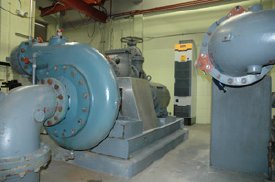Nov 14 2010
The city of Rock Hill, South Carolina has replaced obsolete technology in its wastewater treatment plant with state of the art Parker SSD variable speed drives. Its Wildcat Lift Station was constructed in the 1970s to accommodate rising population and includes three 150kW centrifugal pumps that lift 11 million gallons per day a total of 143 feet (44m).
Until recently pump flow was controlled by an eddy current clutch from the original installation. However, when Maintenance Supervisor Jon White had to deal with the failure of one of the pump’s drive systems, he realised that the repair cost and time were impractical. Instead, he contacted Parker SSD to discuss a new variable speed drive.

Parker estimated cost savings and a calculation on the return of investment (ROI) which showed that in energy savings alone, without consideration for the cost of ongoing maintenance of the existing system, the return period would be less than 12 months. Based on this the decision was made to proceed with the upgrade.
The inefficient eddy current clutch was removed and the existing 150kW, 460 volt, 447T frame motor was directly coupled to the pump shaft, requiring only a simple motor mount modification. The 150kW high power modular AC variable speed drive was then connected through the existing control panel and pump sequencing logic. The available bottom power entry configuration on the drive allowed a neat installation with no visible external wiring.
The need for an expensive additional external harmonic filter was eliminated as the drive includes a 3% line reactor built into its enclosure, as well as line fuses and a local power disconnect switch with door interlock and lockable handle.
Replacing the eddy current clutch with a solid state drive has provided several tangible benefits to Rock Hill over and above the energy savings. For example, eddy current clutches rely on slip to adjust the speed of their load and dissipate energy through heat. Their efficiency also drops off significantly as speed increases and with a 150kW motor, this soon adds up.
On the other hand, by using a variable speed drive to regulate the speed of the pump directly, there is no energy lost to slippage and the current draw of the motor declines dramatically with reduction of speed. With a centrifugal pump, simply reducing the speed to 80% will result in nearly a 50% decrease in energy consumption.
In addition, the motor is now gently ramped up to speed with current limited by the drive. The old Direct-On-Line starting system inflicted significant stresses on the motor, clutch and pump resulting in increased wear and reduced service life. On top of this, the high peak starting current led to higher peak demands which in turn resulted in additional surcharges from the utility company.
While Parker SSD drives are famously reliable, the possibility of component failure does exist. Fortunately their modular design means parts are quickly and easily replaceable.